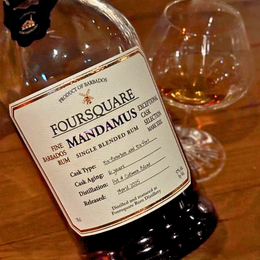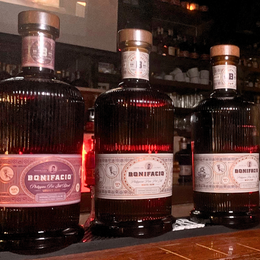
Have you ever wondered how rum became so closely associated with pirates and seafarers of old? It all began with the British Royal Navy which had a tradition of providing rum to sailors stretches back centuries. When some of these sailors eventually left the Navy, they brought their taste for rum with them to wherever their new workplace may be, leading rum to become a popular drink amongst pirates.
Looking back into history, you’ll find that governments often distributed mind-altering substances to their soldiers – American Civil War soldiers sipped on bourbon, French soldiers were given copious amounts of red wine in the World Wars, while German and Finnish soldiers even resorted to methamphetamine pills.
Alcohol too, was deeply ingrained in the traditions of the British Royal Navy. This wasn't just about keeping spirits high; it was also a matter of survival. Back in the day, water stored on ships quickly turned stale and unsafe to drink. In the early 1600s, sailors were given "small beer," a low-alcohol brew less likely to spoil at sea. But as naval voyages grew longer, vast quantities of beer became impractical to store - those barrels took up valuable space and slowed down the ships!

Rum rations were probably the biggest exercise in alcohol distribution in modern history - the British Royal Navy helped bring rums to wherever a ship could go to. (Image Source: Radio Canada International)

The answer came when the British captured Caribbean islands, where they gained access to a more compact and potent spirit: rum. This was sourced from ports like Barbados, Jamaica, Guyana, and later Trinidad. The Royal Navy, in essence, became a pioneer of rum blending, managing one of the largest rum holdings in the world during the 1700s and 1800s. The expertise they developed in blending rums from different origins laid the foundation for the modern rum industry, where blending is a key technique to achieve complexity and balance in flavour. The rum ration, affectionately known as the "daily tot," became a tradition that lasted for centuries.

Rum helped sanitize stagnant water and was even believed to have medicinal properties! In retrospect, probably most of the medicinal properties came from the lime which sailors often mixed with their rum, unknowingly preventing scurvy long before vitamin C was discovered. This rudimentary version of what would later become the Daiquiri cocktail inadvertently contributed to the popularization of rum and lime as a classic combination.
Besides these practical benefits, the daily tot played a vital role in maintaining morale, offering a brief respite from the harsh realities of life at sea. It fostered camaraderie among sailors and even served as a reward system, incentivizing good behaviour and punishing infractions. Initially, sailors received a generous half-pint of neat rum daily, which was around 284 millilitres at a hefty 40-50% ABV. That's equivalent to nine shots of vodka! This high alcohol content not only provided a quick escape from the hardships of naval life but also served as a form of liquid courage, which helped when the captain decides to sail beside a French vessel and begin exchanging cannon fire.

Initially, the Navy considered a brandy ration, but that idea was quickly scrapped because brandy was often the drink of the (French) enemy.
Naturally, concerns about overly intoxicated sailors led Admiral Edward Vernon, nicknamed "Old Grog" due to his grogram (silk and wool) cloak, to order ships to dilute rum with water in 1740, creating the drink known as "grog." By the mid-1800s, the rum ration had been further reduced to just one-eighth of a pint, or about 71 ml per day. Sailors were even given the option to forgo their tot in exchange for extra pay. The rum ration's days were numbered, however.

After World War II, the UK Parliament officially abolished the practice in December 1969 in a move towards a more modern and professionalized Navy. The last day of rum rationing, 31 July 1970, became known as "Black Tot Day," a bittersweet occasion where sailors raised their final glasses of grog. The remaining rum was carefully stored in a shipyard, reserved for special occasions.

Flagons of the pre-1970 British Navy rum.
Fast forward to 2010. Sukhinder Singh, co-founder of The Whisky Exchange and owner of Elixir Distillers, embarked on a quest to track down those remaining flagons of Navy Rum. He succeeded and bottled them as the legendary “Black Tot Last Consignment.”

Read our rum diarist's review of the Black Tot Last Consignment Navy Rum (Source: Weixiang Liu)
Only 3,000 bottles were produced, and this eventually became a highly sought-after collector's item, with prices reaching about US$1,000 per bottle. The rediscovery and bottling of this historic rum sparked a renewed interest in British naval rum tradition and its influence on the rum industry.

But the story doesn't end there. Elixir Distillers later released “Black Tot Finest Caribbean Rum,” a more affordable modern take on the British Navy-style rum. This contemporary blend combines fruity Barbados rum with full-bodied Guyanese rum and funky Jamaican rum, the rums used are mostly aged between 3 and 5 years blended with some unaged rum. While it's not an exact recreation of the original Navy rum, this has been a well-received and accessible tribute to the legacy of the daily tot.
For the spirits geeks out there, the blend is composed of 40% 3 to 5 years old Guyana rum, 35% 5 years old Barbados rum, 20% white Guyana rum and 5% of 3 years old Jamaican high ester pot still rum, all of which have been 100% tropically aged in their countries of origin in ex-bourbon white oak casks, with no sugar or additives added.
Let’s taste a dram of this stuff!
Black Tot Finest Caribbean Rum, 46.2% ABV – Review

Tasting Notes
Nose: A burst of tropical fruits with a touch of funk. Opens with ripe pineapples, then vanilla and caramel notes interweave with the fruit, complemented by the subtle oakiness and scent of polished wood. Rich brown sugar along with hints of smoked orange peel and eventually some funkiness of overripe bananas show up. The overall impression is one of thickness, yet it seems pretty balanced with the sweetness held in check.
Palate: The initial notes mirror the nose. A wave of tropical fruits, with pineapple leading the charge, coupled with quickly unfolding notes of toffee, coffee, bitter chocolate and salted caramel. There’s a festive peak of cinnamon, cloves and some zesty lemon peel. As it develops on the palate, deeper notes of molasses, treacle, Demerara sugar, baking spices and ginger emerge. It’s rich in flavour but fairly moderate in its body, and despite a touch of spice, it’s overall really approachable.
Finish: Long. Tropical fruits fade first, leaving behind a persistent memory of brown sugar, liquorice, and a sweet-herbal aftertaste of Nin Jiom Pei Pa Koa. Also pretty rounded and accessible with a comfortable warmth felt on the back of the throat.

My Thoughts:
This is a solid, people-pleasing rum blend, showcasing those classic Demerara characteristics and a touch of Jamaican funk.
It strikes a balance, offering both the comforting, rich molasses notes that rum enthusiasts crave, and an easy-going nature that welcomes those newer to sipping rums. This is designed to be easy going and balanced, and it intentionally retains lots of freshness that sets it apart from other heavily oaked or high-proof “Navy Rum” style rums.
This is approachable and a very easy to understand casual sipper, but you may also appreciate a subtle complexity that unfolds to reveal more tropical fruit and sweetness through the mid palate.
My Rating: 7/10
|
Score/Rating Scale :
|

@CharsiuCharlie







